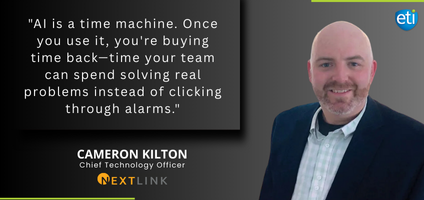
The following summary has been condensed for length and readability. To listen to the full discussion, click here. This episode is sponsored by intelegrate and VETRO FiberMap.
In this episode of The Broadband Bunch, recorded live at WISPAmerica 2025 in Oklahoma City, host Brad Hine speaks with Cameron Kilton, Chief Technology Officer at Nextlink Internet. With over two decades of telecom and broadband experience, Cameron offers a look into how Nextlink is harnessing automation and AI to transform operations and scale broadband access across rural America.
This episode is full of valuable takeaways for ISPs, network professionals, and tech-forward operators looking to innovate responsibly, from lessons in leadership and technical strategy to concrete examples of AI in action.
Cameron’s journey with Nextlink began after years of traveling globally and working in various telecom roles. Drawn to the company’s core mission—connecting underserved communities—he initially joined as a consultant before becoming CTO.
When he started in 2019, Nextlink had about 38,000 subscribers and 400 employees. As of 2025, the company has more than 102,000 subscribers, over 900 employees, and operates in 10+ states, including Texas, Oklahoma, Kansas, Iowa, and Wisconsin. The company is headquartered in Hudson Oaks, Texas, and has grown from a small strip mall office to a multi-building campus with more than 50 locations nationwide.
Kilton attributes this success not only to strategic network investments but also to the strong team culture and a clear commitment to rural broadband expansion.
AI is everywhere—but as Kilton emphasizes, not all that glitters is true AI. In his session at WISPAmerica and throughout the podcast, he draws a critical distinction between:
Real AI (e.g., machine learning, predictive modeling)
Automation/workflows falsely marketed as AI
At Nextlink, roughly 10% of what’s pitched as AI to buyers is actually AI, he says. Much of the value right now lies in automation, which ISPs can leverage without diving headfirst into complex models.
Still, Nextlink is pushing the envelope with several impressive AI use cases.
Here are just a few areas where Nextlink is using AI and automation effectively:
One of their most powerful innovations is a predictive churn model that forecasts, with 40% accuracy, whether a customer will cancel within the next 30 days. This tool has been back-tested for over a year and is now being rolled out across their operations. Kilton suggests it may even be productized for industry-wide use.
Nextlink uses AI to summarize support tickets, analyze customer sentiment, and provide quality assurance feedback. While they’re not yet using AI voice agents, these tools are helping improve customer interactions and agent performance.
Using AI-assisted scripting, Kilton’s team built crawlers to analyze 42,000+ infrastructure devices and flag configurations that didn’t align with internal SOPs. This discovery, which would’ve taken months manually, was completed in just a few hours.
Automation is used extensively to ensure network resilience—automatic failover systems are in place to reroute traffic instantly when outages occur. When issues do arise, workflows are triggered immediately, enabling a faster response before customers even notice.
Data integrity is a recurring theme in Cameron’s strategy. As he explains, successful AI and automation rely on clean, structured data. The adage “garbage in, garbage out” still holds true.
Nextlink prioritizes regular audits and data hygiene efforts, often using AI to spot data anomalies. This foundational work ensures their AI models and automated workflows deliver meaningful results.
Beyond technology, Cameron is passionate about building the right team culture. He believes in homegrown talent and initiative over credentials, noting that one of his top AI team members started in tier-one tech support.
To encourage innovation, he launched an internal event called the CTO Code Jam—a no-rules, hackathon-style week where developers from across the company collaborate on projects, test in production, and break traditional release rules. Last year, this initiative led directly to the creation of several now-live AI systems.
Cameron frames AI as a “time machine.” He argues that automation tools—even simple ones like AI-assisted email writing or presentations—can give staff back valuable time.
This “time dividend” frees up technical teams to focus on high-impact work instead of repetitive tasks, ultimately raising service quality and customer satisfaction.
Despite the enthusiasm, Kilton remains cautious around data governance and security. All AI and automation applications at Nextlink are developed on-premises, avoiding cloud dependencies to protect sensitive customer data. This allows the team to move fast without compromising control.
He’s also skeptical of newer tech like voice biometrics—highlighting privacy risks and the need for robust safeguards before broader adoption.
For broadband providers new to AI, Cameron offers the following tips:
Start small: Tools like ChatGPT, Whisper, and LLaMA are easy entry points.
Don’t fear the tech: AI is accessible—start with low-risk internal uses.
Focus on ROI: Deploy AI where it can save time, cut costs, or improve CX.
Clean your data: Good outcomes depend on good inputs.
Develop your team: Look for initiative, not just resumes. Cultivate a learning culture.
Cameron Kilton’s vision for Nextlink is a powerful example of what’s possible when practical innovation, data discipline, and people-first leadership converge. From building smarter networks to mentoring the next wave of telecom talent, his approach offers a compelling roadmap for rural ISPs looking to scale sustainably and stay ahead of the curve.
“Fail fast, fail forward, and never stop learning.” — Cameron Kilton
© 2025 Enhanced Telecommunications.